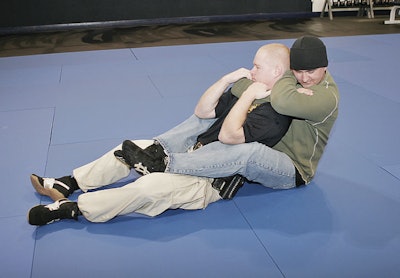 Photo: Jimmy Lee
Photo: Jimmy Lee
Editor's note: View our related step-by-step photo gallery, "Choke Escapes: 2 Techniques."
Mixed Martial Arts (MMA) is a dynamic and entertaining combat sport whose popularity has grown significantly over the last decade, and this multi-million-dollar business appears here to stay. This brings both opportunity and challenge to law enforcement officers. We have the opportunity to learn MMA techniques and training methods that are useful to us. Our challenge is to recognize that we are facing aggressors who have been trained formally in MMA or, at the very least, informally by the entertainment industry that promotes this martial art to use techniques such as choke holds. So how do we meet that challenge? The answer is simple: training.
Training Perspective
MMA practitioners commonly use choking techniques to defeat their opponents. In a match if you are being choked by your opponent you can "tap out" or submit to end the attack before you go unconscious or suffer a severe injury. Law enforcement officers do not enjoy this luxury.
The consequences of your being "choked out" or rendered unconscious are severe. Your aggressor can have his way with you and the weapons on your belt. The danger to you, your fellow officers, and the public is obvious. A choke attack should therefore be considered a critical attack and you should train yourself accordingly. We are going to take a look at two popular choke techniques used effectively by grapplers and MMA practitioners: the rear naked choke and the guillotine choke.
Before we do that, keep in mind two things. First, nothing will replace well trained fundamental skills. We are often looking for the "ultimate method or technique" or the "surefire solution" to our problems. The reality is that where officer safety is concerned, what rules the day are basic fundamental skills developed through consistent, high-quality training. Regardless of what method of defensive tactics or arrest control you use, there are several fundamental skill areas you must develop and maintain at the highest levels throughout your career. Awareness, balance, control, timing, and distance are but a few of these fundamental skills. No technique or weapons system can replace these, including the choke escape techniques we are about to look at.
Secondly, it is frequently pointed out that many if not the majority of the altercations officers are involved in end up on the ground. Assuming this is true, does that make you a "ground fighter?" Be careful if you answer "yes." True ground fighters prefer to be on the ground and are comfortable on their backs. They can turn an inferior position (on their backs) into a superior position with well-practiced techniques. These can surely be useful skills to have. However, we don't fight in padded rings; we don't have referees. And while we have rules, our aggressors do not. When we do fight, we are usually wearing weapons which, if taken from us, can be used against us with lethal consequences. Perhaps most importantly, even the best ground fighter who ties up with an aggressor on the ground will have a difficult time dealing with a second or third person joining the fight. Multiple aggressors are a reality law enforcement officers consistently face.
Many of the young men and women I teach in the Basic Academy program at the Contra Costa County (Calif.) Office of the Sheriff Law Enforcement Training Center already have very impressive martial arts/combat sports backgrounds. Some are even a tough match for my instructors, one on one. The game changer comes when I introduce a second and third aggressor into a combative training exercise. I do this to prove my point that once you tie up with an aggressor on the ground, you become vulnerable to multiple aggressors. Your weapons can be taken from you more easily, and you are susceptible to brutal and vicious strikes such as kicks and stomps. The more quickly you can escape or transition to a dominant position that gives you both stability and mobility, the safer you will be.
I say all this to underscore the notion that even with excellent grappling or "ground fighting skills," your training and your mindset should be geared toward controlling aggressors in ways that minimize risk to you. You will notice that in both choke escape techniques presented here, the emphasis is on escape, both from the immediate threat and from a compromising, prolonged engagement on the ground.[PAGEBREAK]
Rear Naked Choke Escape
As practiced by law enforcement, the rear naked choke technique is commonly referred to as the carotid restraint or lateral vascular neck restraint. Done correctly, it is not a true choke, in that it does not impede breathing by compressing the airway. Rather, it restricts the flow of oxygenated blood to the brain, which is arguably worse for you because unconsciousness comes relatively quickly.
Remember, if someone uses this technique on you and renders you unconscious, you cannot defend yourself or others, and as such, your aggressor can cause you serious bodily injury, or worse, kill you. To avoid this, you'll need to employ four key principles:
- PROTECT the neck
- SET UP the escape
- MOVE to the non-choke side
- ESCAPE to a position of advantage
There are several positions your aggressor can establish to use this technique. Perhaps one of the most difficult to escape from is when your aggressor is behind you with a full wrap on your neck, and both legs wrapped around your waist. Here's what you do:
1. PROTECT the neck. Use both of your hands to pull downward on his wrist
and/or forearm. At the same time, tuck your chin to your chest. Pull hard to relieve as much pressure as you can. Remember, time is of the essence, so establish wrist or forearm control as quickly as you can.
2. SET UP your escape. To do this, plant your feet and push yourself backward. Use your body weight and leverage to get your head even with or beyond your aggressor's head.
3. MOVE to the non-choke side. Bring your shoulder on the choke side to the ground on the non-choke side. Resist the temptation to roll onto your stomach. An experienced grappler will roll with you and onto your back, continuing to apply pressure to your neck.
4. ESCAPE to a position of advantage. Use a hip escape, bringing your legs outside the aggressor's legs.
5. Maneuver to a superior position. You can now transition to your feet or another force option.
Guillotine Choke Escape
The guillotine choke is a true choke because the aggressor is applying pressure to your windpipe. This is a dangerous technique to be on the receiving end of and, like the rear naked choke, should be considered a critical attack. There are a variety of positions and variations of this choke, but let's look at one of the more difficult ones to escape from. The aggressor has you on the ground with a full wrap around your neck and his legs around your waist. Again, employ the same four key principles: PROTECT the neck (throat), SET UP your escape, MOVE to the non-choke side, and ESCAPE to a position of advantage. Here's what you do:
6. PROTECT the neck (throat). Bring your hand on the choke side to the aggressor's wrist and/or forearm and pull downward. Turn your head toward the aggressor's body and reach over the aggressor's shoulder with your free arm.
7. Walk your feet toward the aggressor, keeping them close together. Get your hips up high so that your weight is coming downward on your shoulder, which is pressing forcefully into the aggressor's neck and face. This helps relieve the pressure on your neck and throat.
8. SET UP your escape. Use your hand and forearm to drive down the aggressor's inner thigh on the choke side. You are trying to "break" the lock the aggressor has around your waist by driving his legs below your hips.
9. MOVE to the non-choke side. Scramble or simply fall to the non-choke side, clearing the aggressor's legs.
10. Continue moving your feet away from the aggressor, into a side control position. Drive the aggressor's chin to his choke side shoulder to loosen his choke hold.
11. ESCAPE to a position of advantage. Sprawl and rotate around the aggressor's head to begin breaking his choke hold.
12. Continue moving to the choke side to break the choke hold and assume a superior position. You can now transition to your feet or another force option.
Consider This
My training team and I recently taught these choke escape techniques to 600 law enforcement officers, almost all of whom were not MMA practitioners. Mastery of the techniques was not the goal. Creating an understanding of how critical a choke attack is and demonstrating the key principles of how to defend against it were the objectives. To that extent, we succeeded.
During the training, some officers raised interesting questions such as, "If it's a critical attack, why don't we just draw our gun and shoot the person trying to choke us?" That is clearly a decision that has to be made by the individual officer, and the wisdom and effectiveness of such a decision depends in large part on what stage of the choke attack you find yourself in. We presented these escape techniques in close to "worst case scenarios," where the aggressor had already maneuvered the officer into an inferior position with the choke set and imminent. In these positions, I believe the time it takes to draw and shoot a gun that is already partially blocked by the aggressor's legs is potentially greater than the time it would take to render you unconscious. That being said, we trained officers to mitigate and escape the immediate threat of the choke before attempting to introduce an unholstered gun into the fight.
Watch MMA Fights
Developing and maintaining your awareness of the threats you face on the job is the first step to ensuring your safety. Proper training to address those threats is the next step. If you are not currently paying attention to the MMA scene, please do so; it's amazing what you can learn just watching a few fights. Then, consider the points I have presented, and look for ways you and your co-workers can enhance your personal and departmental training to address the opportunities and challenges MMA brings to law
enforcement.
Lt. James Harbison is the Basic Academy Coordinator at the Contra Costa County (Calif.) Office of the Sheriff Law Enforcement Training Center, where he teaches defensive tactics and physical fitness.











